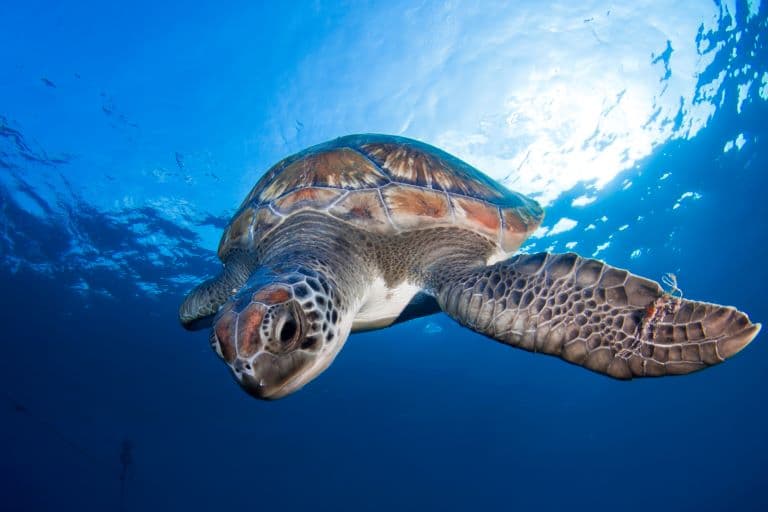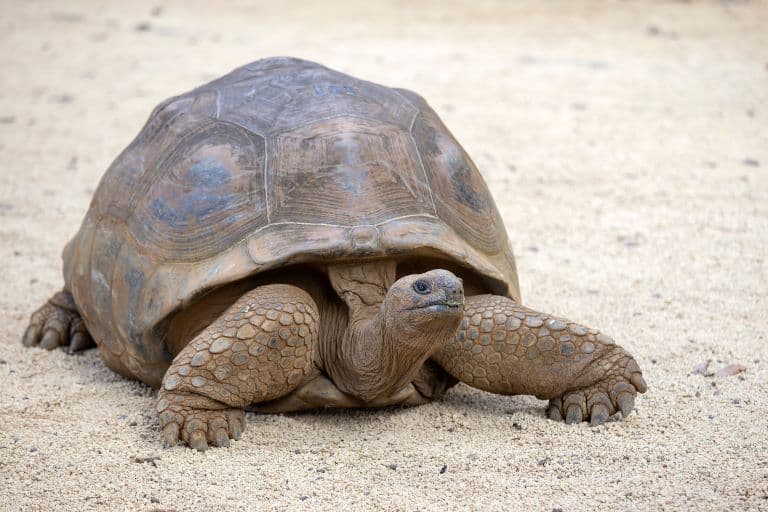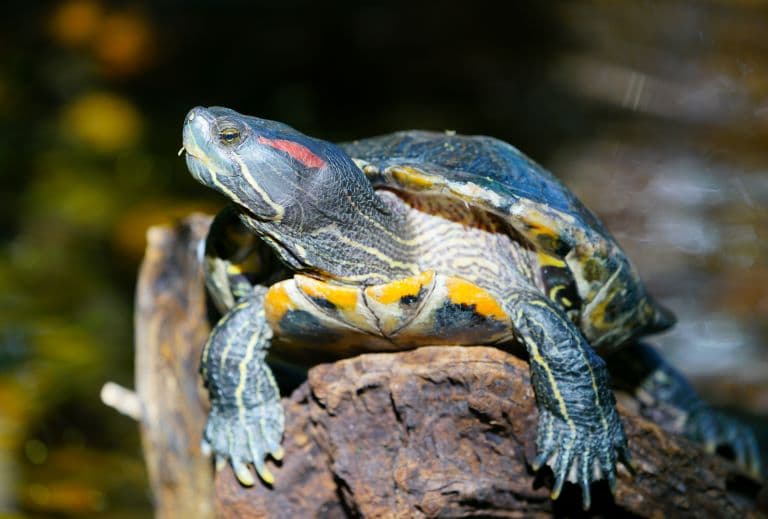Turtle Profile
In the world of extant reptiles, crocodiles get most of the glory. These prehistoric-looking predators excite us because they’re scary and old. But there’s another class of reptile that has been around through thick and thin and has survived to be more widespread than the crocs.
The turtles are humbler, (usually) more gentle animals, and while they’re ancient, charismatic giants, their time might be running out.

Turtle Facts Overview
| Habitat: | Varied: widespread on land, marine, freshwater, ponds, swamps |
| Location: | Every continent except Antarctica |
| Lifespan: | Likely upwards of 187 years in some cases |
| Size: | Can grow to over two meters (7 ft) long |
| Weight: | Leatherback turtles can weigh up to 900kg (2000lb) |
| Colour: | Varied, usually greens and browns |
| Diet: | Opportunistic omnivores |
| Predators: | Sharks, mammals, birds, humans |
| Top Speed: | Usually slow, some swim up to 30km/h (22 mph) |
| No. of Species: | 360+ |
| Conservation Status: | Many are Critically Endangered (IUCN) |
Turtles are a very diverse group of reptiles. While the order Crocodilia contains about 25 species, Testudines has over 360.
Yet, the majority of these are now threatened with extinction.
They cover both land and sea, freshwater, saltwater and brackish estuaries. Swamps and mangroves, ponds and lakes.
These charming animals are unusual, even for reptiles, and can grow to enormous proportions. But without a radical overhaul of our industrial fishing practices, they won’t be around much longer.
Interesting Turtle Facts
1. They’re Testudines
It seems like everyone has a different understanding of what a turtle is. Taxonomically, Turtle is just the name for the order of Testudines, which houses all shelled reptiles from the humble terrapin to the Galapagos giant tortoise and all things in between.
In British English, the word turtle is reserved for all but the terrestrial testudines, known as [tortoises], but in US English it’s truer to the order as a whole.
Turtles all have a shell, mostly made from bone. Keratinous scales cover it for added strength and different species have differing levels of flexibility with this. Leatherbacks are so-named for their leathery, bendy backs, whereas you could (but shouldn’t) break a wooden bat on some species of tortoise.
Again, you shouldn’t do this.
Within Testudines, there are three major groups: the hard ones, the soft ones, and the ones with the long necks. Hard and soft-shelled turtles are more closely related, with the vast majority of species being hard-shelled.
2. Land turtles
There are fifty or so turtle species that don’t swim (although they can float, which is how they ended up colonising island chains all over the world) and these are known as the [Tortoises].
The overwhelming majority of turtles live in water, with around 300 species ranging from very small, to enormous. There are some long-distance marine swimmers and others who prefer living in and out of ponds.

3. They’ve got weird heads
For a long time, turtle lines were assumed to be ancient, based on the lack of holes in the skull. Since animals learned to encase their eggs in protective membranes (shells in birds and reptiles, amniotic sacs in most mammals), there have been three different types of skull morphologies emerging.
Some, like most reptiles (including dinosaurs), have two holes behind the eye. These are known as Diapsids. Others, like mammals, have one and are called Synapsds. Those with no openings are called Anapsids, and it’s thought that the one-hole and two-hole skull shapes evolved from skulls with none.
Therefore, when seeing that turtles have no holes, it was a reasonable conclusion to draw that they must predate dinosaurs and have split off before the amniote skull shape diverged.
But it’s recently been established that the history of turtle skull evolution evolved through a Diapsid phase and returned to an Anapsid one. So, while amphibians retain the primitive anapsid skull, turtles reverted to it much later. 1
4. They have multiple solutions to the neck problem
Some of the ways turtles are differentiated from one another is by how they protect their necks. Having shells is great and all, but you need to be able to fit inside it when necessary, and long necks create a problem.
Some turtles turn their neck sideways because they’re too long to retract straight in. These are called the side-necked turtles. Others have a hinge in the shell to close it up over their faces, as seen in the box turtles, and most just retract them as far as they can for protection. Sea turtles can’t fully retract their necks at all! 2

5. They can live a long time
Slow-growing reptiles often grow to large sizes, and turtles are no different. The third largest reptile is the leatherback sea turtle at 2.7 meters, but the oldest in the fossil record was a 5.35 meter-long giant from the Cretaceous.
It’s estimated that this one would have weighed over two tonnes, while the heaviest today is around 900kg.
Reaching this size takes several decades and the Leatherback can live for more than 50 years. But in the relatively peaceful and safer environment of the islands, an undisturbed tortoise can live for over 190 years. 3
6. They are sometimes smart
Tortoises are about as dumb as they look, but other species of turtle have shown to be a lot brighter. Some freshwater turtles have been witnessed communicating with one another using clicks, squeaks, hoots and chirps, and red-bellied cooters have shown long-term memory and potential play. 4

7. They can embark on incredible migrations
Sea turtles are an icon of migratory species, well known for their epic voyages from the open ocean to traditional birthing sites.
They’re the only reptiles to migrate like this and they can travel thousands of kilometres doing so. How they found their way back to the exact site of their birth has been a focus of study for decades and remains a bit of a mystery.
Chemical cues and the magnetic field of the Earth likely come into play, but there appears to be something in their DNA that we haven’t figured out yet. 5
8. We’re losing them
Sadly, without our help, we might run out of turtles even before we figure out their secrets. After primates, whose homes we have decimated, turtles are the most threatened of all vertebrates.
83% of Asia’s marine species are threatened and over half of all species in the world. This extinction of turtles is occurring faster than the mass extinction that occurred at the end of the Cretaceous period and is entirely the work of humans.
Nesting sites are being destroyed and turtles themselves are being slaughtered for illegal trade. They’re also a constant victim of bycatch from the fishing industry, something which indiscriminately kills billions of animals a year. Millions of these are turtles.
Turtle Fact-File Summary
Scientific Classification
| Kingdom: | Animalia |
| Phylum: | Chordata |
| Class: | Reptilia |
| Order: | Testudines |
| Family: | At least 14 families |
Fact Sources & References
- Axel Meyer (2001), “The evolutionary position of turtles revised”, Research Gate.
- George R. Zug (1998), “side-necked turtle”, Britannica.
- “Leatherback Turtle”, NOAA Fisheries.
- “How Smart Are Turtles? (This May Come Unexpected To You)”, The Turtle Hub.
- “Sea Turtle Migration”, seeturtles.org.
